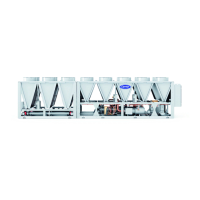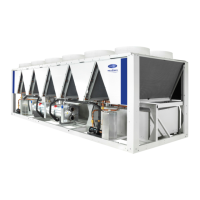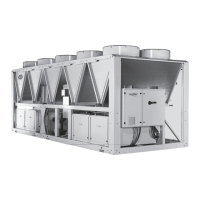52
SERVICE
Economizer Assembly —
Each circuit on the unit has
an economizer assembly, which includes a brazed plate heat
exchanger, electronic expansion valves (EXVs), and other
components. See Fig. 47.
Electronic Expansion Valve (EXV) — See Fig. 48
for a cutaway view of the EXV. High-pressure liquid refriger-
ant enters the valve through the top. As refrigerant passes
through the orifice, pressure drops and refrigerant changes to a
2-phase condition (liquid and vapor). The electronic expansion
valve operates through electronically controlled activation of a
stepper motor. The stepper motor stays in position unless pow-
er pulses initiate the two discrete sets of motor stator windings
for rotation in either direction. The direction depends on the
phase relationship of the power pulses. The motor directly op-
erates the spindle, which has rotating movements that are trans-
formed into linear motion by the transmission in the cage as-
sembly. The valve cone is a V-port type which includes a posi-
tive shut-off when closed. The large number of steps and long
stroke results in very accurate control of the refrigerant flow.
The stepper motor has either 3810 (main) or 2625 (economiz-
er) steps.
MAIN EXV CONTROL — The main EXV is controlled
by the SIOB (J17-STPR1). Each circuit has thermistors lo-
cated in the discharge line compressor (DGT), compressor
motor cavity (SGT) and liquid line leaving the condenser
(LIQT). Each circuit also has a discharge (DPT), suction
(SPT), and liquid line pressure transducer (LPT). All the
pressure readings as measured by the transducers are con-
verted to saturated temperatures. The main control logic for
the EXV uses liquid line subcooling, which is the difference
between the liquid line saturation temperature and the liquid
line temperature, to control the position of the EXV. The
SIOB module controls the position of the electronic expan-
sion valve stepper motor to maintain the subcooling set
point. The EXV control logic has several overrides, which
are also used to control the position of the EXV.
• Normal Mode (SUBCOOL)
• Low Discharge Superheat (DSH)
• Low Suction Pressure (SPMIN)
• Maximum Suction Pressure (SPMAX)
• EXV Start (START)
To view EXV overrides: Main Menu Maintenance Menu
EXV Control or EXVECO Control.
Normal Mode (SUBCOOL)
— This is the normal mode of
operation of the EXV. Based on the operating condition and
loading of the compressor, the control calculates an optimal
subcooling setting to maximize the system efficiency. The con-
trols accordingly adjust the EXV opening to meet this calculat-
ed subcooling setting. The range of the subcooling setting can
be altered by using the Network Service Tool in the Configura-
tion EXV_CFG table.
Low Discharge Superheat (DSH)
— The EXV control goes
into the DSH mode when the DSH is below 16.2 F (9 C). The
EXV closes down to increase the discharge superheat beyond
16.2 F (9 C) and returns to the SUBCOOL mode.
Low Suction Pressure (SPMIN)
— The EXV control tries to
open up the EXV to increase the suction pressure and come out
of this mode. The SST setting to enter this mode is dependent
on the fluid type. With water the EXV enters this mode if SST
is less than 25 F (–3.9 C) in normal discharge superheat or less
than 13 F (–10.6 C) in low DSH condition. It remains in this
mode until SST is greater than 34 F (1.1 C) or greater than 25 F
(–3.9 C) if subcool is greater than subcool setpoint.
Maximum Suction Pressure (SPMAX)
— The EXV enters
this mode if the suction saturation temperature (SST) is greater
than 55 F (13 C). The EXV closes down to regulate the SST at
about 53.2 F (11.8 C). If the SST is less than 52.3 F (11.3 C)
then the EXV returns to the normal mode of operation.
ECONOMIZER EXV CONTROL — The economizer EXV
is controlled by the SIOB (J18-STPR2). An economizer gas
temperature thermistor (ECT) and an economizer pressure
transducer (EPT) are located in the line running from the econo-
mizer assembly to the compressor. The economizer pressure is
converted to saturated temperature and is used to calculate econ-
omizer superheat. Economizer superheat equals economizer
temperature minus saturated economizer temperature. The con-
trol system controls the economizer EXV to maintain the econo-
mizer superheat setpoint, which is approximately 18 F (–7.8 C).
If the circuit capacity is less than 50%, the economizer EXV
will be closed.
Fig. 46 — Transducer and Switch Locations
SUCTION PRESSURE
TRANSDUCER (SPT A)
OIL SEPARATOR (A)
OIL PRESSURE
TRANSDUCER (OPT A)
ECONOMIZER PRESSURE
TRANSDUCER (EPT A)
LIQUID LINE PRESSURE
TRANSDUCER (LPT A)
EVAPORATOR (B)
COMPRESSOR (B)
DISCHARGE PRESSURE
TRANSDUCER (DPT A)
SUCTION PRESSURE
TRANSDUCER (SPT B)
OIL PRESSURE
TRANSDUCER (OPT B)
ECONOMIZER PRESSURE
TRANSDUCER (EPT B)
LIQUID LINE PRESSURE
TRANSDUCER (LPT B)
DISCHARGE PRESSURE
TRANSDUCER (DPT B)
OIL LEVEL SWITCH
(OIL LS B)
EVAPORATOR (A)
COMPRESSOR (A)
HIGH PRESSURE
SWITCH (HPS B)
HIGH PRESSURE
SWITCH (HPS A)
EVAPORATOR FLOW
SWITCH (CWFS)
OIL SEPARATOR
(B)
OIL LEVEL SWITCH
(OIL LSA)
POWERBOX END

